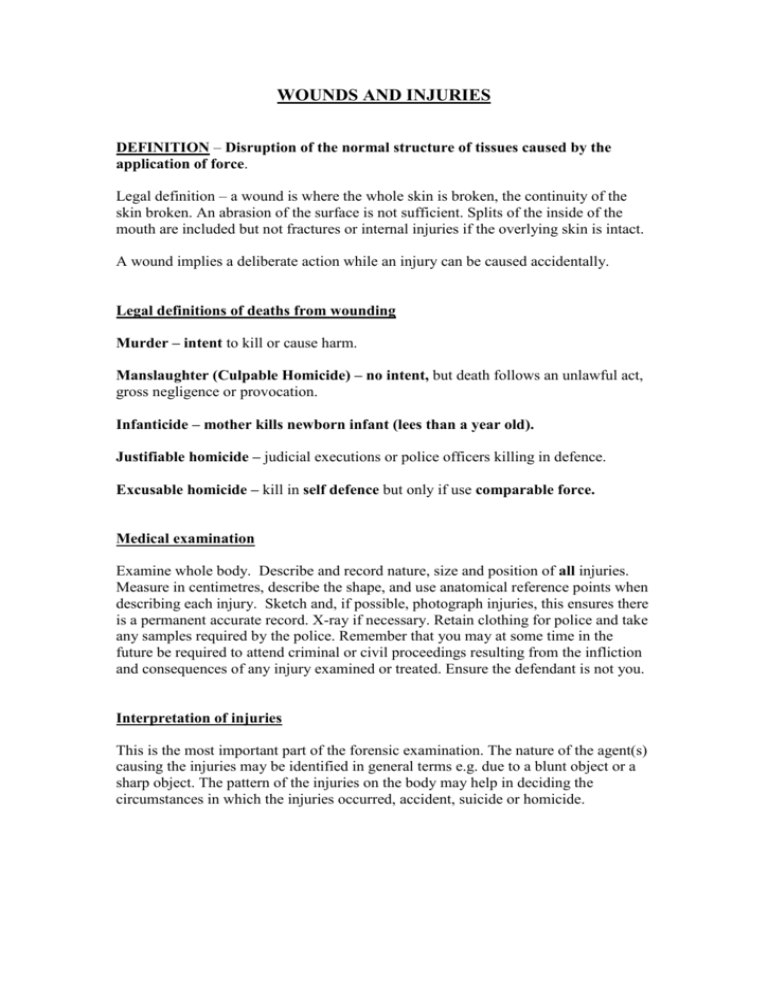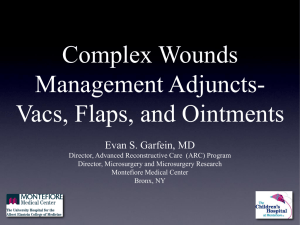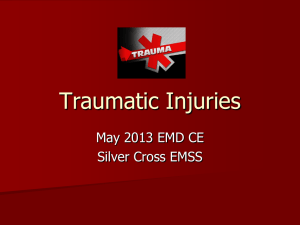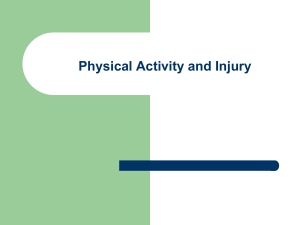wounds
advertisement

WOUNDS AND INJURIES DEFINITION – Disruption of the normal structure of tissues caused by the application of force. Legal definition – a wound is where the whole skin is broken, the continuity of the skin broken. An abrasion of the surface is not sufficient. Splits of the inside of the mouth are included but not fractures or internal injuries if the overlying skin is intact. A wound implies a deliberate action while an injury can be caused accidentally. Legal definitions of deaths from wounding Murder – intent to kill or cause harm. Manslaughter (Culpable Homicide) – no intent, but death follows an unlawful act, gross negligence or provocation. Infanticide – mother kills newborn infant (lees than a year old). Justifiable homicide – judicial executions or police officers killing in defence. Excusable homicide – kill in self defence but only if use comparable force. Medical examination Examine whole body. Describe and record nature, size and position of all injuries. Measure in centimetres, describe the shape, and use anatomical reference points when describing each injury. Sketch and, if possible, photograph injuries, this ensures there is a permanent accurate record. X-ray if necessary. Retain clothing for police and take any samples required by the police. Remember that you may at some time in the future be required to attend criminal or civil proceedings resulting from the infliction and consequences of any injury examined or treated. Ensure the defendant is not you. Interpretation of injuries This is the most important part of the forensic examination. The nature of the agent(s) causing the injuries may be identified in general terms e.g. due to a blunt object or a sharp object. The pattern of the injuries on the body may help in deciding the circumstances in which the injuries occurred, accident, suicide or homicide. NATURE OF INJURY Blunt force injuries 1. Abrasions 2. Bruises 3. Lacerations Injuries due to sharp and/or long insruments 1. Incised wounds 2. Stab wounds Others 1. Weals 2. Glass injuries 3. Axe wound 4. Thermal injuries 5. Firearm injuries 6. Defence injuries 7. Self inflicted wounds Abrasions The most superficial of injuries. An injury to the surface of the skin, confined to the cuticle or surface layers of the epidermis. If it penetrates the upper dermis the injury can bleed. May be described as a graze or a scratch. Caused by a rough surface striking the body tangentially, removing the outer layer of the skin, the movement between the two surfaces scraping off the epidermis, causing a pile up of the epidermis at the far end, ‘skin tags’. There may also be directional, linear scratches across the injury. Perpendicular force applied to the skin surface can cause crushing of the epidermis, forming a pressure or imprint abrasion, which may have the outline of the causative object. If abrasions are caused at about the time of death, or after, e.g. due to dragging the body after death, they will have a golden yellow or orange appearance described as ‘parchmenting’. These injuries remain static. Abrasions are common in falls. They can be long and thin, scratches, or broad, grazes, ‘brush abrasions’, ‘gravel rash’ or ‘friction burns’. Some abrasions show a distinctive pattern e.g. ligature mark on the neck, fingernail marks or scratches, teeth marks or bite marks, tyre marks (run over) and belt or rope marks. Kicking, stamping and blows from specific objects such as a hairbrush can leave a specific mark. Haphazard linear scratches can be caused by contact with bushes whereas parallel linear markings can be due to directional movement e.g. dragging and small abrasions are caused by glass fragments e.g. in a road traffic accident. Fragments of material, glass, paint, gravel etc. may be embedded in the abrasions, indicating their cause. Bruises Due to blunt force trauma applied to the person or the person striking a solid surface, e.g. blows with an object, direct pressure (fingers) or falling. The surface epithelium is unharmed but the connective tissue is crushed and the small blood vessels, arterioles and veins, rupture and blood escapes into the tissues. Blood spreads along lines of cleavage, natural or due to the trauma, and therefor the bruise may not accurately reflect the shape of the causative object. Intradermal bruises may retain the pattern of the object e.g. a tyre. The margins of the bruise may blur and the bruise can shift due to the effects of gravity e.g. spreading down the neck from the scalp. During the period after death, while the blood in the vessels remains fluid, blunt force can result in a bruise on the deceased. It may take up to 48 hours for a bruise to develop in the living or dead and therefore it can be helpful to re-examine at a later date. Scalp bruises are often undetectable at first. The extent of a bruise depends on the site of the injury, as well as the age and health of the individual. Children and the elderly have a greater tendency to bruise, as do those with nutritional deficiencies, such as vitamin C, or with haemorrhagic tendencies ( alcoholics ) or haematological disorders ( haemophiliacs, thrombocytopenia ). In these cases the bruise may have a blotchy appearance, described as purpuric, in the elderly ‘senile purpura’. ‘Petechial’, or finely patterned pinpoint bruises, can be caused by shearing forces or sucking (love bite), in areas of congestion or in conditions resulting in hypoxia/asphyxia. Bruises are commonly encountered in assaults due to punching, kicking, being struck by a blunt object or contacting with the ground. In common assaults the injuries are principally to the face, hands, arms or legs. In sexual assaults finger bruises may be found on the upper thighs and similar bruises are seen on the neck in manual strangulation and the arms if gripped or grabbed. They are also found in simple falls or falls from a height and in RTAs. One specific pattern is the ‘tramline’ bruise, caused by a long narrow object striking the body e.g. stick or snooker cue. The vessels under the area struck being compressed and blood squeezed out to the vessels at the edge of the area struck, these vessels becoming engorged and rupturing, forming two lines of bruising either side of the band of skin struck, which remains pale. Bruising should not be confused by postmortem hypostasis. The blood in hypostasis remains in the vessels and the two can be distinguished by cutting open the skin. Lacerations The most severe, and potentially dangerous, of the skin wounds. A laceration is a breach in the full thickness of the skin, sometimes referred to as a split, tear or gash. It can be caused by a direct blow crushing the skin, which is stretched or torn, mostly in sites where the skin directly overlies bone, the scalp, face, shins etc., as the skin is fixed and splits easily. Lacerations can also be caused by shearing or tearing forces, the rolling or grinding movement separating and tearing the skin e.g. in RTAs, the most severe being a degloving injury. They commonly have a linear appearance and therefore are mistakenly identified as incised wounds. However the edges are often ragged and the margins of the wound bruised and abraded. In the depth of the wound the tissues are not cleanly divided but irregular, the tougher structures, such as vessels and nerves, remaining intact. Some are irregular in shape, or stellate (hammer), usually due to a direct blow from a heavy object, the shape of the laceration corresponding to the striking surface of the weapon. Lacerations are encountered in assaults due to kicking or blows from a weapon as well as in falls and RTAs. Lacerations, particularly on the scalp, can bleed profusely. Incised wounds Incised wounds, cuts, slices or slashes are due to sharp cutting instruments, commonly knives, razor blades or any object with a sharp or cutting edge. Their lengths are greater than their depths, tending to be long shallow wounds, and the wound margins are uninjured. The exceptions to this are some injuries due to broken glass and axe injuries, which can appear irregular or the margins damaged. The wound may be deeper initially and become shallower as the blade is drawn across the skin. Often the blood vessels, nerves and tendons under the skin can be severed resulting in haemorrhage, paralysis, loss of sensation and even loss of function. The depths of these wounds must be explored to exclude such damage. In ‘glassing’ incidents glass fragments may be found in the wound. Incised wounds can occur accidentally, in ‘self-harm’, suicide attempts and assaults, the pattern of the injuries indicating the circumstances. The common sites are face, neck, forearms and wrists. In suicide attempts classically the wounds are on the neck and wrists, sometimes the groin, are usually multiple, parallel and symmetrical. The depth of the wounds may vary and there are usually very shallow incisions or scratches as well as deeper wounds, the smaller wounds known as tentative injuries. In assaults injuries are typically found on the face (marking), arms and hands (defence injuries) or even across the neck (cut-throat). Self inflicted injuries are commonly on the arms and trunk, are very shallow and are longer and more haphazardly placed than ‘suicidal’ injuries. Stab or penetrating wounds Penetrating injuries can be caused by any long object, which can penetrate the skin, but are more usually due to knives. These are the most dangerous wounds as they often penetrate the body cavities or deep enough to damage major vessels and vital organs e.g. the heart. The depth of the wound is greater than the length of the surface injury. They can be described as penetrating, piercing deep into the tissues, or perforating, transfixing and exiting the tissues or deep organs. About 50% of homicides in UK and Ireland result from stabbing incidents. There may be only one fatal wound or numerous wounds, with or without incised wounds. They can also occur accidentally and in suicide attempts. In suicides the injuries are commonly to the front of the chest or in the groin and there may even be multiple stab wounds, as well as the more typical incised wounds to the wrists. The number, position, size and shape of each wound should be recorded. The shape may reflect the shape and width of the blade of the weapon e.g. a knife with a single sharp edge may cause a boat shaped injury pointed at one end and squared off at the other. However the shape may be altered due to elastic recoil of the skin distorting the appearance of the wound or movement of the weapon in the wound may enlarge the wound causing an irregular defect in the skin. Blunt objects penetrating the skin may cause irregular surface injuries, which may be mistaken for lacerations. The depth and internal damage cannot be predicted from the external appearance and weapons can penetrate more deeply into the body than might be expected for their length, due to compressibility of the body tissues. Miscellaneous injuries Weals Within one minute of an injury e.g. scratch, there is a red line response followed by a weal which developes within 2 to 5 minutes and which may remain for one to several hours. This is due to the triple response to injury i.e. local dilation of the capillaries and small venules, followed by dilation of the neighbouring arterioles and finally oedema. Dermatographia is an exaggerated response to a less intense stimulus. Defence injuries Caused in attempts to defend oneself from an attack. They can be found on the arms, hands, legs or back. The type of injury will indicate the type of assault e.g. blunt force or an assault with a knife. Self inflicted wounds 1. Self-harm injuries; usually with sharp weapon (see incised wounds). 2. Suicide wounds; usually incised or stab wounds (see previous). 3. ‘Manipulative’ wounds; person may have personality disorder; may be inflicted while in custody in order to get into hospital. 4. False accusation of injury in assault. 5. Claims for compensation. 6. Drug related injuries, due to injecting and sometimes ‘self-harm’ or suicide attempts. 7. Tattoos, tribal markings, piercings. DETERMINING THE AGE OF INJURIES The age of an injury in the living is determined by the changes seen over a period of time. These are dependent on the site of the injury, the age of the person and the size of the injury. Naked eye appearance Abrasion The fresh injury has an exudate on its surface. This will dry and a scab will form within 24hours. Depending on the size, the scab will detach in a few days leaving a pink surface, and will heal completely within 4 or 5 days. Bruise As the haemoglobin in the bruise is metabolised the colour of the bruise changes from purple/red/blue to brown (after a few days), to green (within a week), to yellow, which fades after 2 weeks. This process can be accelerated to a few days in children and prolonged for several weeks in the elderly. Also depending on the size and site of the bruise the colour and the rate of healing may differ even in the same person. Laceration Within 12 hours the wound margins will be red and swollen. A scab will form in the wound within 24 hours and, depending on the size, can be healed within 4 to 5 days. Histological examination In practice it is often difficult to be precise. Depends on variable factors as before. Within a few minutes capillaries are dilated (triple response) and there is margination of the leucocytes, One hour – emigration of leucocytes, reaction of tissue histiocytes, swelling of vascular endothelium. 12 hours – emigration of monocytes, fibroblastic reaction. 15 hours – mitotic activity in fibroblasts. 72 hours – vascularised granulation tissue. 4 to 5 days – fibrous tissue. 7 days – fibrous scar. DEATH FROM INJURIES Primary 1. Haemorrhage : hypovolaemic shock (loss of 500mls no reaction, loss of 1 litre symtoms, loss of 2 litres danger to life); inhalation of blood ; mass effect inside skull (extradural, subdural or subarachnoid) or pericardial sac (cardiac tamponade). 2. Damage to a structure vital to life : brain ; heart ; lung. 3. Shock : neurogenic due to a reflex neurovascular disturbance, either parasympathetic inhibition of circulation (vaso-vagal cardiac arrest) or sympathetic/adrenal stimulation (fright, fight or flight) which could be responsible for death in the presence of chronic cardiac disease. Death may be fairly rapid if a large vessel or the heart is damaged or within a few days if intracranial bleeding occurs. Delayed 1. Infection : sepsis of the wound or bronchopneumonia. 2. Pulmonary thromboembolism. 3. Acute tubular necrosis 4. Fat embolism : occurs about 24 hours after injury, heralded by rise in temperature and petechial haemorrhages, due to damaged fat invading damaged veins, entering the pulmonary veins, heart and systemic circulation, embolising to the brain and kidneys. Internal injuries Blunt force trauma 1. Severe force can cause bone fractures internally. 2. Trauma to the head can result in a skull fracture and brain injury, typically in severe assaults and RTAs but also in falls. 3. RTAs are also associated with long bone fractures. 4. Direct trauma to the chest, sufficient to fracture the ribs, can crush the heart (right atrium), tear the aorta (junction of arch and descending thoracic), puncture or contuse the lungs and be complicated by pneumothorax or haemothorax.. 5. Direct trauma to the abdomen can cause lacerations to the solid organs and perforation of the hollow organs. Intra-abdominal haemorrhage may not be immediately obvious and injuries may not be immediately painful. Penetrating injuries Cannot fully predict internal injuries from the site of the external wound e.g. a chest wound may perforate the diaphragm and transfix abdominal organs.









